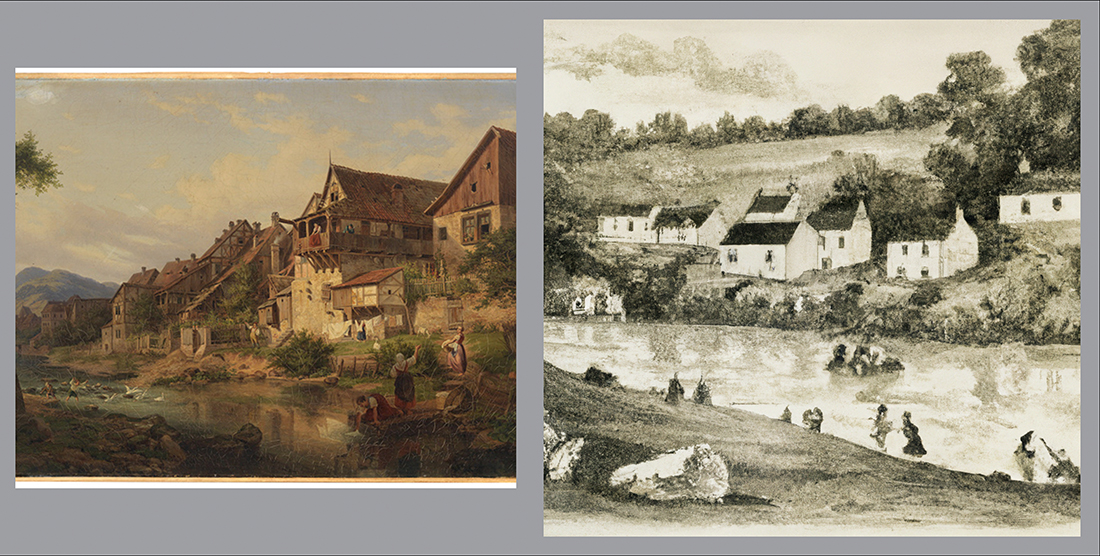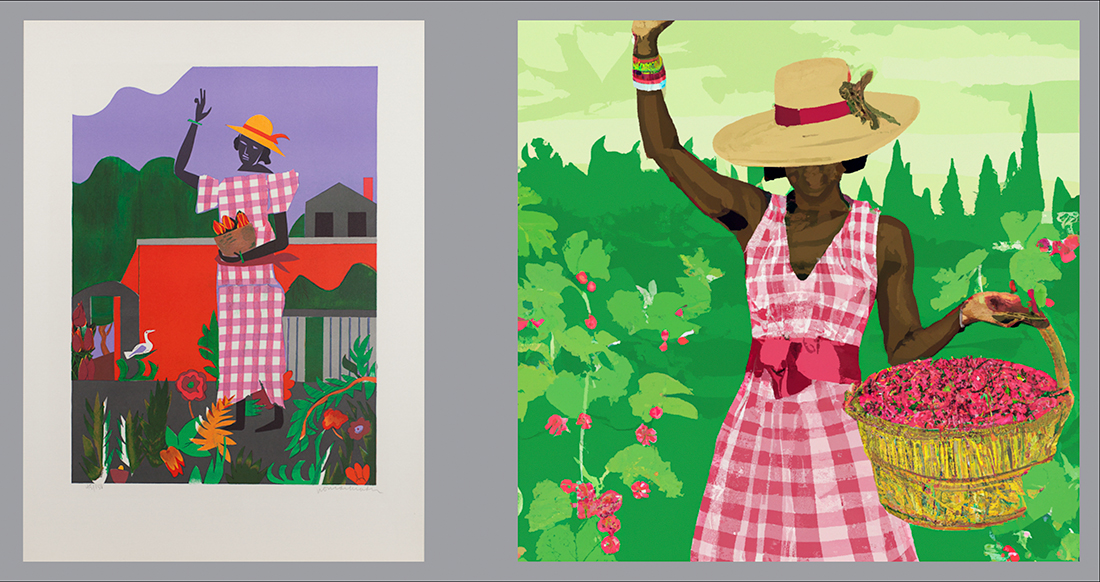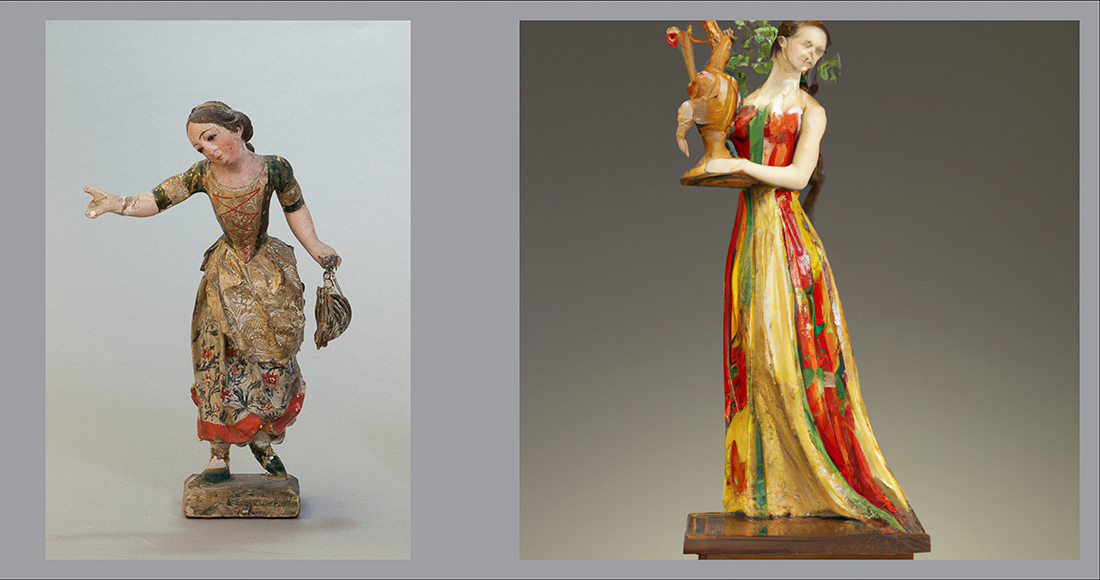Visitors crowded into a Fayerweather hallway one evening in mid-November, examining pairs of artworks that looked unmistakably similar… but not exactly the same. One of each pair was a print of a work from the Mead Art Museum collection. The other was an attempt to replicate that work using the Open AI computer program DALL-E. The event was billed as Amherst’s “first exhibition of art generated through artificial intelligence.”
Through exposure to numerous examples from the internet, DALL-E has been trained to create visual representations when prompted with textual descriptions. For this exhibition, Reihaneh Iranmanesh ’25 later explained, the prompts for each artwork were descriptive captions taken directly from the Five Colleges Collections Database.
Comments from the audience raised many questions:
- How does the use of AI compare to older practices of collage or sampling?
- Could we someday create an AI art critic?
- What about issues of profit motive, copyright, forgery and deepfakes (manipulated footage that falsely depicts what people have done or said)?
“There were only two instances where the prompt was altered very slightly,” said Wendy Espinosa ’25. An illustrated panel from an early Christian church had to be specifically identified as a “mosaic,” and for Guidoccio Cozzarelli’s Virgin and Child with Angels, the name “Mary” had to be added to the prompt; otherwise the AI program would flag the depiction of “The Virgin, wearing a red dress…” as inappropriate. “If you wish to use DALL-E to recreate these paintings effectively, those two words are quite crucial!” Espinosa said.
She and Iranmanesh are part of the Artificial Intelligence in the Liberal Arts initiative, led at Amherst by Lee Spector, the Class of 1993 Professor of Computer Science. That evening in Fayerweather, Spector moderated a panel discussion on DALL-E, featuring three assistant professors of computer science: Scott Alfeld, who studies the security concerns surrounding AI; Lillian Pentecost, who focuses on the future of computer memory systems; and Will Rosenbaum, who researches abstract computational models of distributed systems. They talked to the audience—some two dozen students, staff, faculty and members of the public—about how DALL-E works and its broader technological context.
Spector asked, “What do you see as the prospects for AI to become an ‘artist’?” The panelists agreed that AI programs will be able to follow instructions to produce larger quantities of imagery faster than human artists can, and for less money. “But can they assess the significance of it?” Spector wondered.
Artists have always relied on advances in technology. Does using a camera count as creating art?
Yael Rice, associate professor of art and the history of art and of Asian languages and civilizations, also on the panel, pointed out that artists through the ages have relied on advances in technology, and on the labor of assistants and apprentices who follow their instructions. Similar questions to those we’re now asking about AI have historically been asked about, for example, photography: Does using a camera, “a tool that seems to reproduce what we see with human vision,” count as creating art?
Toward the end of the discussion, Rice reminded everyone of the “specter of bias.” Human beings have prejudices and gaps in our understanding (regarding race, gender, language and so much more), so any algorithms we design are likely to reflect and reproduce those biases. For better and worse, the machines are learning from us.
Dall-E has been trained to create visual representations from textual prompts. How did it do with three Mead works?

Left: Gottfried Pulian, View of the Environs of Dresden, undated (19th century), at the Mead Art Museum
Right: DALL-E– generated artwork
Prompt: “A row of cottages along the bank of a river with people standing on verandas, clothes hanging on lines; at lower right women doing their washing in the stream; at the left, boys chasing geese in the water. In the middle ground at left, a small hill.”

Left: Romare Bearden, In the Garden, 1979
Right: DALL-E– generated artwork
Prompt: “A dark-skinned woman in a pink checkered dress stands at the center, a straw hat covering her bobbed hair, green bangles on her wrist. Her right hand is raised into a wave while her left hand is holding up a basket of bright red fruit to her waist. Behind the woman, we see greenery in the background, as well as a grey building with a red chimney in the distance and, closer to the woman, a red structure.”

Left: Artist unknown, Figurine of a Woman with Chicken (Mujer con Pollo), late 18th century
Right: DALL-E– generated artwork
Prompt: “Figure of a young woman, standing with head tilted to one side, one arm outstretched, the other by her side holding a chicken. Long dark hair, with gold ribbon in back. Tight-bodiced gown with green bodice, red and gold skirt with sprigs of flowers; gold apron. Small wooden base.”